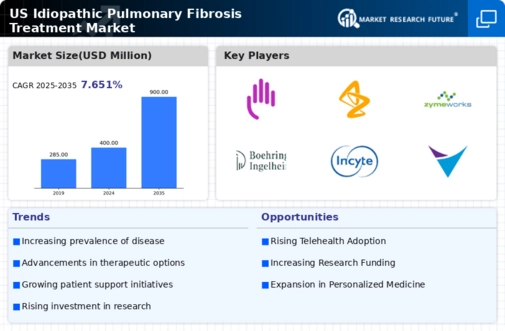Advancements in Diagnostic Technologies
Technological advancements in diagnostic tools are significantly impacting the idiopathic pulmonary-fibrosis-treatment market. Enhanced imaging techniques, such as high-resolution computed tomography (HRCT), allow for earlier and more accurate diagnosis of IPF. This early detection is crucial, as it enables timely intervention and treatment, which can improve patient outcomes. Furthermore, the development of biomarkers and genetic testing is facilitating personalized treatment approaches, thereby increasing the effectiveness of therapies. As diagnostic technologies continue to evolve, they are likely to lead to a higher rate of diagnosis and treatment initiation, ultimately driving growth in the idiopathic pulmonary-fibrosis-treatment market. The integration of these technologies into clinical practice is expected to enhance patient management and optimize therapeutic strategies.
Growing Awareness and Education Initiatives
The rise in awareness and education initiatives surrounding idiopathic pulmonary fibrosis is significantly influencing the idiopathic pulmonary-fibrosis-treatment market. Various organizations and healthcare providers are actively working to educate both the public and medical professionals about the disease, its symptoms, and the importance of early diagnosis. Campaigns aimed at increasing awareness are likely to lead to more patients seeking medical attention, which in turn drives demand for treatment options. Additionally, educational programs for healthcare providers can enhance their ability to recognize and manage IPF effectively. As awareness continues to grow, it is anticipated that the idiopathic pulmonary-fibrosis-treatment market will experience increased patient engagement and treatment uptake.
Regulatory Support for Innovative Therapies
Regulatory support for the development of innovative therapies is a crucial driver for the idiopathic pulmonary-fibrosis-treatment market. The US Food and Drug Administration (FDA) has implemented various initiatives to expedite the approval process for new treatments, particularly for rare diseases like IPF. This includes the designation of orphan drug status and fast track designations, which encourage pharmaceutical companies to invest in research and development. As a result, there is a growing pipeline of novel therapies aimed at addressing the unmet needs of IPF patients. The favorable regulatory environment is likely to stimulate innovation and competition within the idiopathic pulmonary-fibrosis-treatment market, ultimately benefiting patients through improved treatment options.
Increased Investment in Healthcare Infrastructure
The expansion of healthcare infrastructure in the US is a notable driver for the idiopathic pulmonary-fibrosis-treatment market. With increased funding and investment in healthcare facilities, there is a greater capacity to provide specialized care for patients with IPF. This includes the establishment of dedicated pulmonary clinics and the availability of multidisciplinary teams that can offer comprehensive treatment options. Moreover, the rise in telemedicine services has improved access to care for patients in remote areas, facilitating timely consultations and treatment plans. As healthcare systems continue to evolve and adapt to the needs of patients, the idiopathic pulmonary-fibrosis-treatment market is likely to benefit from enhanced service delivery and patient engagement.
Rising Prevalence of Idiopathic Pulmonary Fibrosis
The increasing incidence of idiopathic pulmonary fibrosis (IPF) in the US is a primary driver for the idiopathic pulmonary-fibrosis-treatment market. Recent estimates suggest that approximately 200,000 individuals are currently living with IPF in the US, with an annual incidence rate of about 30,000 new cases. This growing patient population necessitates the development and availability of effective treatment options, thereby propelling market growth. As awareness of the disease expands among healthcare professionals and the public, more patients are likely to seek diagnosis and treatment, further stimulating demand within the idiopathic pulmonary-fibrosis-treatment market. Additionally, the aging population, which is more susceptible to respiratory diseases, contributes to the rising prevalence, indicating a sustained need for innovative therapies.























Leave a Comment